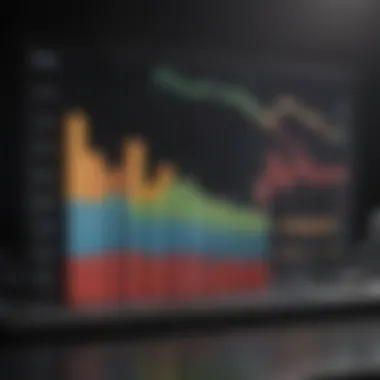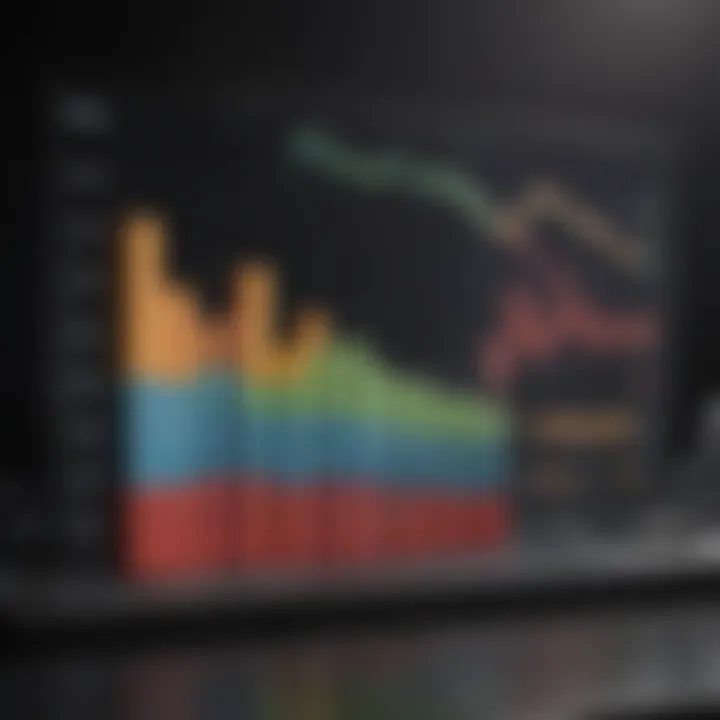Analyzing the Blackstone High Yield Bond Fund


Intro
The Blackstone High Yield Bond Fund stands as an intriguing entity in the realm of fixed-income investing. With its focus on high-yield bonds, it attracts attention from a variety of investors, each seeking to uncover potential opportunities and risks tied to such investment vehicles. In an era where interest rates rise and geopolitical factors loom large, understanding the nuances of this fund has become vital.
Navigating the high-yield bond market is not for the faint-hearted. It requires a blend of astute observation and strategic thinking. This article endeavors to dissect the Blackstone High Yield Bond Fund, spotlighting its investment strategies, performance metrics, and its broader relevance in today's economic backdrop. Our aim is to bolster your knowledge, ensuring you can approach high-yield investments with a well-informed mindset.
In the following sections, we delve deeply into the current market environment, the fund’s position within it, and the tools and strategies that investors can employ. By parsing through key indicators and performance data, we will equip readers with a rounded perspective, whether they're just dipping a toe into the investment waters or are seasoned traders honing their strategies.
Let us embark on this exploration and get a grasp of what lies behind the curtain of the Blackstone High Yield Bond Fund.
Intro to the Blackstone High Yield Bond Fund
The Blackstone High Yield Bond Fund represents a significant opportunity in the realm of fixed-income investment. High-yield bonds, commonly known as junk bonds, have garnered attention due to their potential for higher returns compared to traditional investment-grade bonds. However, along with this alluring potential comes a set of risks and considerations that investors must be aware of. This section serves as a crucial jumping-off point to understand the dynamics surrounding the fund and its place within the broader market landscape.
Understanding the Blackstone High Yield Bond Fund is particularly pertinent for both novice and seasoned investors alike. While the high yield may sound attractive, it's essential to grasp the nuances associated with these investments. The fund opens up various paths for generating income, but there are underlying factors influencing performance that will be explored throughout this article.
Understanding High Yield Bonds
High-yield bonds are distinct due to their lower credit ratings, which reflects a greater likelihood of default when compared to safer, investment-grade bonds. This risk factor is balanced by the higher yield offered to investors as compensation for the potential pitfalls. In essence, high-yield bonds can act as a double-edged sword; they can either lead to substantial gains or significant losses, depending on market conditions.
Unlike traditional bonds, which may include debt from stable companies or governments, high-yield bonds often originate from businesses facing financial challenges or those in emerging industries. Investors diving into this area must conduct diligent research to assess both the potential returns and the inherent risks related to specific bonds or fund strategies. As economic cycles ebb and flow, these bonds may react differently—scholarly analysis and real-world experience help paint a clearer picture of their viability as investments.
Overview of Blackstone Group
Understanding the entity managing the Blackstone High Yield Bond Fund is vital. Blackstone Group is known not only for its vast real estate investments but also for a diverse portfolio that encompasses various financial products. Founded in 1985, Blackstone has established itself as a formidable player in alternative investment, fundamentally altering perceptions around asset management.
The firm’s reputation for thorough research and seasoned analysis translates into their approach towards high-yield bonds. Their strategy hinges on extensive market knowledge and analytical prowess, allowing them to navigate the complicated waters of high-yield investing effectively. Moreover, investments are not merely evaluated in isolation but are instead looked at within the framework of overall market conditions.
In summary, while the Blackstone High Yield Bond Fund offers enticing possibilities, it also demands a careful consideration of its investment strategies and the broader economic environment. As we progress through this piece, we'll delve deeper into the fund's operational strategies, performance metrics, and how this fits into the investment landscape, enriching our understanding of high-yield bonds and what they can mean for future financial health.
Investment Strategy of the Fund
When it comes to understanding the Blackstone High Yield Bond Fund, the investment strategy is pivotal. This strategy serves not only as a roadmap but also as a flashlight, illuminating the path that the fund takes through the often murky waters of high-yield bond investments. An effective investment strategy allows the fund to navigate the ever-changing dynamics of the market, focusing on maximizing returns while actively managing risks.
There are a few key elements to this strategy that deserve a closer look. First, the governance structure plays a crucial role in decision-making regarding which assets to invest in and how to manage those assets consistently. Second, a thorough grasp of market trends enhances the fund's adaptability in responding to shifts. Lastly, having a robust risk framework ultimately fortifies its attractiveness for both beginners and seasoned investors.
Asset Selection Process
Selecting the right assets isn’t just a one-off task; it's a continual process that shapes the heart of the fund's performance. The asset selection process involves identifying securities that offer the potential for high yields, but with the caveat of acceptable risk levels. Blackstone employs a rigorous evaluation framework that incorporates both quantitative metrics and qualitative assessments.
For instance, when looking at a particular bond, Blackstone analyzes factors such as the issuer's credit rating, financial ratios, and even industry trends. The idea is to weed out the diamonds in the rough while steering clear of risky potholes. Furthermore, the fund's approach might include:
- Sector analysis: Understanding which sectors are poised for growth or are experiencing headwinds can guide investment choices.
- Cash flow considerations: Evaluating an issuer's ability to service its debt is pretty crucial. If cash flow is robust, chances are the issuer can meet their obligations.
Overall, this complex asset selection process is not just about chasing higher returns but is deeply rooted in strategic foresight.
Risk Management Framework
In the realm of high-yield bonds, risk is omnipresent. Hence, the risk management framework can be likened to the foundation of a house; without it, everything else is at risk of collapse. The Blackstone High Yield Bond Fund employs a multi-faceted approach to risk management that considers various factors that might impact bond performance.
For example, the fund assesses credit risk, which focuses on the likelihood of default by bond issuers. They continuously monitor financial health indicators and market positions to make informed decisions. Additionally, liquidity risk is another important consideration; a bond that is hard to sell might not be a valuable asset, no matter how high its yield.
Risk management can involve techniques like stress testing, where hypothetical scenarios are created to evaluate how the fund might perform under adverse conditions. The goal here is simple yet effective: to withstand storms and emerge relatively unscathed.
Diversification Approach
A well-balanced portfolio is akin to a well-cooked meal; the right mix of ingredients can keep you nourished and satisfied. In the context of the Blackstone High Yield Bond Fund, diversification allows investors to spread risk across a broader spectrum of assets. By investing in various bonds from different sectors and geographical regions, the fund mitigates the impact of poor performance in any one area.
Key advantages of this diversification strategy include:
- Risk reduction: By holding bonds from various industries, the fund can reduce the likelihood that a downturn in one sector will dramatically affect overall fund performance.
- Yield enhancement: Through access to a varied range of bonds, there’s a potential for improved returns, as some sectors might experience growth despite sluggish others.


In summary, the investment strategy behind the Blackstone High Yield Bond Fund is well-thought-out, carefully implemented, and pays dividends for different types of investors. Combining asset selection, risk management, and diversification creates a dynamic approach that stands as a solid façade against market headwinds.
Performance Overview
Evaluating the performance of the Blackstone High Yield Bond Fund is crucial for any investor looking to understand its effectiveness and reliability. This section delves into various aspects, such as historical returns, benchmarks, and volatility metrics, that collectively provide insights into how the fund has fared and what implications these results have for potential investors.
Understanding performance is not just about looking at numbers; it's about interpreting those numbers within the broader market context. For example, an impressive return might stem from a booming economic period, whereas underwhelming returns could be a result of broader market disruptions. Recognizing this context helps investors make more informed decisions.
Historical Returns Analysis
When discussing historical returns, we must take a closer look at the actual performance data over time. The Blackstone High Yield Bond Fund has, over various market cycles, delivered returns that are particularly noteworthy for investors interested in high-yield bonds. By reviewing historical data, we can determine the average annual return and variances during different economic climates.
This analysis is essential for several reasons:
- Guidance on Expectations: Investors can derive realistic expectations for future performance based on past data, which serves as a barometer for assessing whether the fund meets their financial goals.
- Trend Spotting: Identifying trends in returns can provide insights into the fund’s management effectiveness and adaptability to changing market conditions.
- Comparative Analysis: Historical data aids in comparing the fund's performance against peer funds, giving investors a clearer perspective on its competitiveness.
Comparison with Benchmarks
No financial analysis is complete without a solid benchmark to measure performance against. In the case of the Blackstone High Yield Bond Fund, it is often compared to indices such as the ICE BofA US High Yield Index. This provides a clear picture of whether the fund is keeping pace with, or lagging behind, industry standards.
Key considerations in this comparison include:
- Relative Performance: Understanding how a fund performs in relation to its benchmark gives investors a plethora of insights into its strengths and weaknesses.
- Risk-Adjusted Returns: Simply looking at returns isn't enough. The fund’s returns should be assessed based on the risks taken, compared to its benchmarks. A fund can show high returns but might also have taken on significantly more risk.
- Contextual Analysis: Lessons learned from comparing against a benchmark can highlight whether the fund has mechanisms in place for proactive management during adverse market conditions.
Volatility Metrics
Volatility is another critical metric when evaluating the performance of funds, particularly in an unpredictable market like high-yield bonds. The Blackstone High Yield Bond Fund's volatility metrics shed light on the potential risk an investor might face.
Understanding volatility involves analyzing:
- Standard Deviation of Returns: This indicates how much the fund's returns deviate from the historical average. A high standard deviation reflects greater risk, while a low number signifies stability.
- Beta: This compares the fund’s volatility against the broader market. A beta greater than one indicates the fund is more volatile than the market, while a beta less than one suggests it is less volatile.
- Downside Risk: Evaluating potential losses during downturns is crucial. It is not just about how much a fund can gain but also how much it might lose in turbulent times.
"Performance metrics are not just numbers; they are narratives telling the story of risk, management effectiveness, and market conditions."
Market Environment and Economic Implications
Understanding the market environment and its economic implications provides essential insight into the performance and potential of the Blackstone High Yield Bond Fund. Economic indicators and market dynamics serve as the backbone for any investment strategy, particularly in the realm of high-yield bonds, where the stakes and rewards can be considerable. A detailed exploration of this theme not only enhances comprehension for investors but also aids in making informed decisions that align with their financial goals.
Current Economic Landscape
Navigating the present economic landscape is akin to walking a tightrope; it requires balance, precision, and foresight. Several major factors currently influence this landscape:
- Inflationary Pressures: Persisting inflation has prompted shifts in monetary policy, affecting both bond yields and overall investor sentiment.
- Employment Rates: High employment levels typically bode well for consumer spending, strengthening corporate earnings and, consequently, the performance of high-yield bonds.
- Global Supply Chain Dynamics: Disruptions in global supply chains can have ripple effects on various industries, impacting the creditworthiness of issuers within the fund.
Each of these elements intertwines, creating a complex environment that requires diligent monitoring.
Impact of Interest Rate Changes
Interest rate fluctuations echo through the bond markets, and the high-yield sector is no exception. When interest rates rise, the cost of borrowing increases for companies, raising alarm bells among investors. This pressure can lead to:
- Higher Default Risks: Companies with less financial flexibility could struggle to meet their obligations, which in turn, affects the fund's yield.
- Investment Flows: As interest rates increase, traditional investments may become more appealing, drawing capital away from high-yield funds. This can put additional strain on bond price integrity.
- Adjustments in Allocation: Fund managers may need to realign portfolios, looking for value in a shifting landscape to adapt to rising costs and changing yields.
"High-yield investing is not simply about chasing higher returns; it’s about understanding how macroeconomic variables breathe life into bond evaluations."
Global Market Trends
In a world that’s more interconnected than ever, global market trends wield seismic influence over localized economies. Observing these trends helps to paint a bigger picture for investments in high-yield bonds:
- Emerging Markets: Growth potential in economies like India or Brazil offers intriguing opportunities for high-yield investment but carries its own sets of risks, including political instability and currency fluctuations.
- Geopolitical Considerations: Tensions such as trade wars or sanctions against nations can rattle market confidence, leading to turbulence in bond markets. A shaky global environment can prompt investors to rethink their positions in riskier assets.
- Technological Disruptions: Technology is reshaping industries at breakneck speed. Companies in sectors that adapt quickly thrive, while those that lag could fall out of favor, directly impacting bond valuations.
The interplay between global trends and local market conditions is intricate, and discerning their impact is vital for future investments in the Blackstone High Yield Bond Fund. With changes in economics affected by local, regional, and international events, keeping an eagle eye on these shifts is necessary.
Analyzing Risks Associated with High Yield Bond Funds


High yield bond funds present a unique opportunity for investors looking to achieve returns that may surpass those of traditional investment-grade bonds. However, with good prospects come inherent risks. It's crucial to dive into the nuances of analyzing risks associated with these funds. Understanding these pitfalls can arm investors with the knowledge needed to make sound decisions while optimizing their portfolios.
When discussing high yield bonds, investors should not overlook the complexities that surround them. High yield bonds are often issued by companies with lower credit ratings, which means they carry an increased risk of default compared to their investment-grade counterparts. Thus, engaging in a thorough risk assessment is pivotal for anyone considering this type of investment.
Let's break this down further by looking at three main areas of concern: credit risk, liquidity issues, and market risk factors.
Credit Risk Assessment
One of the most significant risks in high yield bonds is credit risk. This term refers to the potential that an issuer will fail to meet its financial obligations, such as failing to make interest payments or repaying the principal upon maturity. For high yield bonds, the stakes are higher due to the lower credit ratings of the issuing companies.
In assessing credit risk, investors need to take several factors into account:
- Company Financials: A comprehensive review of the issuing company's financial statements can provide insights into its stability. Look at metrics such as debt-to-equity ratios and overall profitability.
- Credit Ratings: Agencies like Moody’s or Standard & Poor’s offer ratings that gauge the issuer's creditworthiness. Lower-rated issuers present a steeper risk but also potential for greater returns.
- Economic Conditions: Economic downturns can exacerbate credit risk. In tough times, even companies that seem stable in good markets can falter.
Investors should evaluate the issuer's credit profile regularly. By keeping a finger on the pulse of their investments, they can react promptly to any warning signs that appear.
Liquidity Concerns
Liquidity risk refers to the possibility that an investor may not be able to sell their bond easily without significantly affecting its price. High yield bonds can be less liquid than other investment-grade securities. In other words, finding a buyer for these bonds when the market is sluggish may prove tricky.
Here are several aspects to watch for:
- Market Demand: The overall market condition impacts liquidity. When investors are skittish, even fundamentally strong bonds may encounter hurdles in selling.
- Trade Volume: Bonds with lower trading volumes often suffer from greater liquidity risk. If a bond isn't traded frequently, it can be challenging to sell it at a fair market value.
- Bid-Ask Spread: The difference between the price a seller wants and the price a buyer is willing to pay can be wider for high yield bonds, reflecting their liquidity concerns.
Investors focusing on liquidity should be prepared to hold their investments longer, at least until market conditions improve.
Market Risk Factors
Lastly, in a universe of investments, market risk factors loom over high yield bonds. This includes broader economic changes, interest rate risks, and geopolitical tensions that could affect bond prices negatively.
Consider some of the following:
- Interest Rates: Generally, when interest rates rise, bond prices fall. This inverse relationship poses a risk particularly for longer-duration bonds.
- Economic Indicators: Things like employment rates, inflation, and GDP growth can sway investor sentiment and thus influence the market performance of high yield bonds.
- Geopolitical Instability: Events such as war or political unrest can create uncertainty, affecting the overall market environment and, subsequently, the bonds’ performance.
Market risk is somewhat unpredictable, necessitating a proactive approach. Keeping abreast of global news could help mitigate this risk as part of a broader investment strategy.
Evaluating Fund Fees and Expenses
Evaluating fund fees and expenses is a crucial aspect when considering any investment, including the Blackstone High Yield Bond Fund. Understanding how these fees impact returns helps investors make informed decisions. In the world of high-yield bonds, where margins can be thin, every penny counts. High fees can gnaw away at returns, making it imperative to grasp what one is actually paying for.
Management Fees Explained
Management fees are the fees charged by the fund manager for overseeing the fund’s investments. These fees typically cover salaries, office expenses, and research costs. The management fee for Blackstone High Yield Bond Fund is generally expressed as a percentage of the fund's total assets under management. A common range for management fees in high-yield funds is between 0.5% to 1.5%. However, it's crucial to read the fine print, as these numbers can fluctuate based on various factors.
Investors need to understand exactly what services are being provided for those fees. Are there multiple layers of fees? For instance, if a fund utilizes a sub-advisor or invests in other funds, additional charges can crop up, leading to a bigger bite out of returns. A prudent investor should ask:
- What specific services are included in the management fee?
- Are there any performance-related fees?
- How do these fees compare with similar funds in the market?
Understanding these particulars can highlight whether the management fees are justifiable.
Expense Ratios and Their Impact
Expense ratios provide insight into the total costs associated with a fund, expressed as a percentage of the fund's assets. This ratio encompasses management fees, operational costs, and, at times, other expenses like trading costs. A lower expense ratio often correlates with better long-term performance, especially in high-yield bond funds where every cost can dilute investor returns.
For the Blackstone High Yield Bond Fund, maintaining an attractive expense ratio is vital. High yield bonds can be more volatile, so controlling costs can directly impact performance. Investors should consider the following when looking at expense ratios:
- Comparison with Industry Standards: How does the Blackstone fund’s expense ratio stack up against competitors? If it's significantly higher, it may warrant further scrutiny.
- Impact on Returns: Even a seemingly small difference in expense ratios can add up over the long run. For example, a fund with a 1% expense ratio may yield considerably less than a similar fund with a 0.5% ratio over a five or ten-year period.
- Transparency: Are the expenses clearly outlined in the fund’s documentation? Investors should demand clarity on where their money is going.
"Understanding fund fees is, in essence, understanding your investment's potential. Choices can shape your financial future."
In summation, evaluating the management fees and expense ratios of the Blackstone High Yield Bond Fund brings clarity to the cost of investing. By scrutinizing these financial metrics, investors can ensure they are not only aware of the costs but can assess if the fund aligns with their investment goals.
Suitability for Different Investor Profiles
Understanding the suitability of investments for varying investor profiles is crucial, especially when dealing with complex options like high yield bonds. These bonds often present higher returns, but they naturally come with greater risks. This section aims to clarify how the Blackstone High Yield Bond Fund aligns with different types of investors, whether they're institutions or individuals, and the factors impacting their investment choices.


Institutional vs. Retail Investors
Institutional investors, such as pension funds and endowments, differ substantially from retail investors, who might just dabble in investment as part of their savings approach. Institutional investors generally have more experience, expertise, and resources at their disposal. Due to these advantages, they often seek out funds like the Blackstone High Yield Bond Fund to bolster their fixed income portfolios. Their larger capital allows them to absorb higher volatility, which is a characteristic of high yield bonds.
On the other hand, retail investors typically have less extensive resources and experience. They may approach high yield investments in a more cautious manner, factoring in risks more heavily when making investment decisions. Retail investors often prefer more straightforward investment means, such as mutual funds or ETFs, which provide diversification and reduce risk through pooled assets. It’s vital these investors understand that while high yield bonds can offer attractive returns, they can also expose them to considerable risks if not carefully managed.
"Tailoring an investment strategy to fit the profile of the investor can make all the difference in light of market fluctuations, especially in the realm of high yield bonds."
Risk Tolerance Considerations
Risk tolerance plays a pivotal role in the decision-making process for investors evaluating high yield bond funds. It essentially reflects the level of risk an investor is willing to accept based on their individual circumstances.
Institutional investors usually possess a higher tolerance for risk, as their investment horizons can stretch longer, and they often have diversified portfolios that can absorb potential losses. They may also possess better tools for assessing risks associated with specific high yield bonds. In contrast, retail investors must weigh their personal financial situations more carefully. Losses can be more impactful on individual finances, leading to a more conservative approach in this segment of the bond market.
When assessing suitability, consider these factors:
- Investment Goals: Are the goals long-term growth or short-term gains? High yield bonds might sway towards long-term strategies if market conditions become less favorable.
- Financial Circumstances: Individual liquidity needs should influence how much risk is acceptable. Institutions often have more stable cash flows compared to retail investors.
- Time Horizon: How long can the investor afford to lock up their capital in these bond investments? Longer time horizons can help ride out market volatility.
Thus, understanding these distinctions can empower investors, whether institutional or retail, to navigate the waters of high yield bonds with greater confidence and clarity. By classifying these profiles well, the Blackstone High Yield Bond Fund can cater its offerings effectively, ensuring that both types of investors find valuable opportunities that match their unique investment needs.
Building a Diversified Portfolio
When it comes to investing, the old adage holds true: don’t put all your eggs in one basket. This is especially relevant in the context of the Blackstone High Yield Bond Fund. A diversified portfolio is critical, as it helps investors manage risk while aiming for a more stable return over time. Here, we dive into how high yield bonds can be incorporated into a broader investment strategy, the benefits involved, and key considerations to keep in mind.
Including High Yield Bonds
High yield bonds are often seen as the bold contenders in the world of fixed income investments. Their potential for higher returns comes coupled with increased risk, which is why their inclusion in a diversified portfolio needs careful thought. By mixing these bonds with other asset classes, canny investors can capture the upside while cushioning against potential downturns.
- Enhanced Yield: Adding high yield bonds can significantly elevate the overall yield of a portfolio. For instance, when market conditions favor these bonds, they can yield far greater returns compared to traditional government bonds.
- Different Risk Profile: The risk associated with high yield bonds is fundamentally different from that of equities or government securities. This diversity allows for better risk-adjusted returns across the portfolio.
- Low Correlation with Stocks: Often, high yield bonds do not move in tandem with stock prices, providing a counterbalance when equity markets face turbulent times. This anti-cyclical behavior can be a lifeline during bearish phases in the stock market.
"Diversification is a protection against ignorance. It makes very difficult to make serious mistakes." – Warren Buffett
Balancing Risk and Return
Finding that sweet spot between risk and return is the name of the game in finance. This becomes particularly important when high yield bonds make their way into a portfolio. Investors can't simply chase high returns without keeping a close eye on the associated risks.
To achieve a sensible balance, one might consider:
- Asset Allocation: Establishing an asset allocation strategy that reflects personal risk tolerance is paramount. If someone prefers a conservative approach, a blend of high yield bonds and safer investments can help maintain desirable risk levels.
- Regular Rebalancing: Continually adjusting the portfolio to maintain intended limits is essential. As certain assets perform better than others, rebalancing ensures that a portfolio does not stray too far from its original risk profile and goals.
- Monitoring Market Conditions: High yield bonds can be influenced by various economic factors, such as interest rates and credit risk perceptions. Keeping an eye on these conditions can allow for timely decisions on whether to increase or decrease exposure to high yield bonds.
End and Future Outlook
The closing section of this article carries significant weight as it encapsulates the critical discussions about the Blackstone High Yield Bond Fund. This is where we bring together the threads of analysis and exploration to provide a clearer picture of what lies ahead for investors.
Key elements of this conclusion include a review of the major themes we have addressed: investment strategies, performance metrics, risk assessments, and market conditions. Recognizing how these various factors interconnect helps investors make informed decisions. Understanding these dynamics is essential, especially in an evolving economic landscape.
Recapping Key Insights
As we venture into the final stretch, it’s important to highlight the main takeaways from our exploration:
- Investment Strategy: The Blackstone High Yield Bond Fund employs a rigorous selection and risk management process to optimize returns while navigating market uncertainties.
- Performance Metrics: Historical performance stands as a testament to the fund's resilience and adaptability amidst shifting market conditions.
- Market Environment: Continuous changes in interest rates, combined with global economic trends, pose both challenges and opportunities for high-yield investments.
- Risk Management: Understanding credit risk and liquidity concerns are fundamental in assessing the fund's viability.
These insights not only paint a comprehensive picture of the fund’s current standing but also set the stage for evaluating future projections.
Projections for High Yield Markets
Looking ahead, the outlook for high yield bonds is influenced by several crucial factors. One primary consideration is the trajectory of interest rates. If rates remain steady or decline, this could bolster demand for high yield bonds as investors seek alternatives with better returns compared to traditional fixed-income options. Conversely, an upward trend in interest rates typically means a headwind for high yield markets, potentially leading to increased volatility.
Another pertinent aspect is the economic recovery following crises, such as the pandemic. A robust recovery might enhance corporate earnings, improving the credit profiles of issuers within the high yield space. Alternatively, prolonged economic struggles could result in heightened defaults.
In summary, while the market for high yield bonds holds promise, it is fraught with uncertainties that necessitate close monitoring.
Final Recommendations
For both novice and seasoned investors contemplating high yield bonds, here are several recommendations:
- Conduct Thorough Research: Spend time understanding the specific dynamics of the Blackstone High Yield Bond Fund, including its investments and strategies.
- Diversify Your Portfolio: Avoid putting all your eggs in one basket. High yield bonds should be part of a diversified investment approach, balancing potential returns with acceptable risk.
- Be Aware of Market Conditions: Stay informed about economic indicators and market trends as they can affect your investments profoundly.
- Consult Financial Advisors: If unsure about navigating the high yield landscape, reaching out for professional advice can provide tailored insights and strategies.
Investing in high yield bonds can be rewarding, but it requires a careful and informed approach to minimize risks and capitalize on potential returns.



